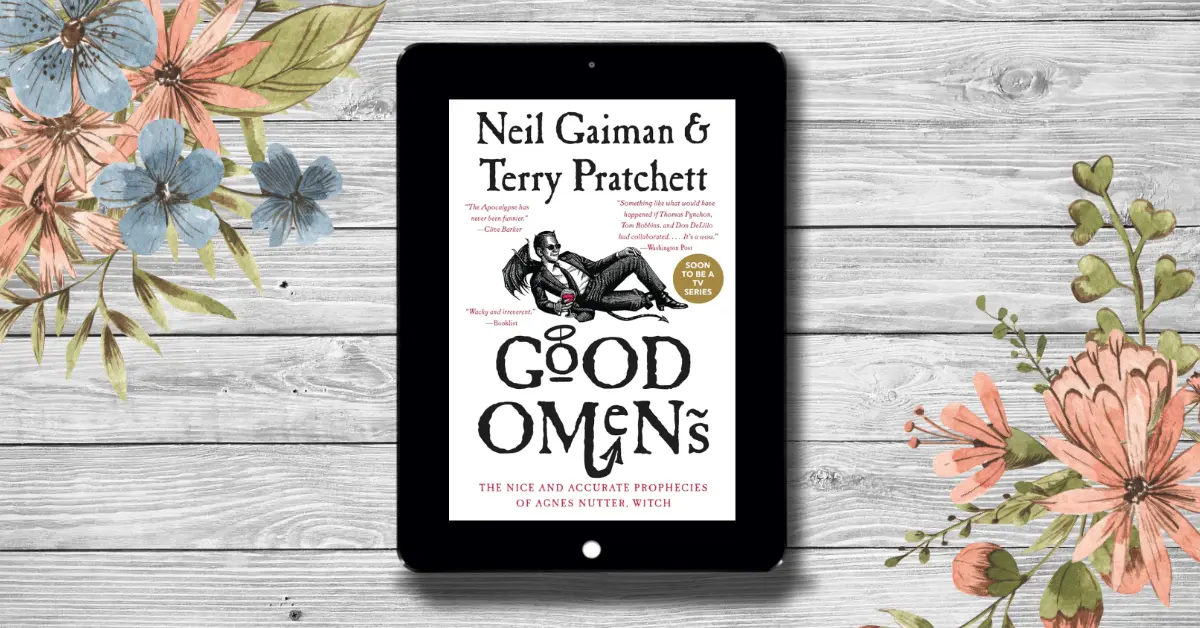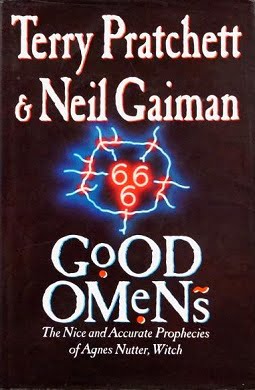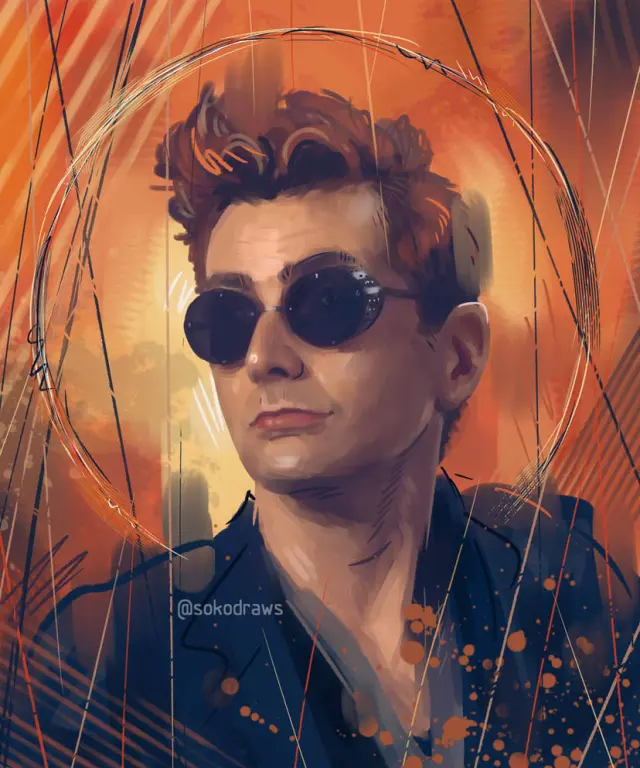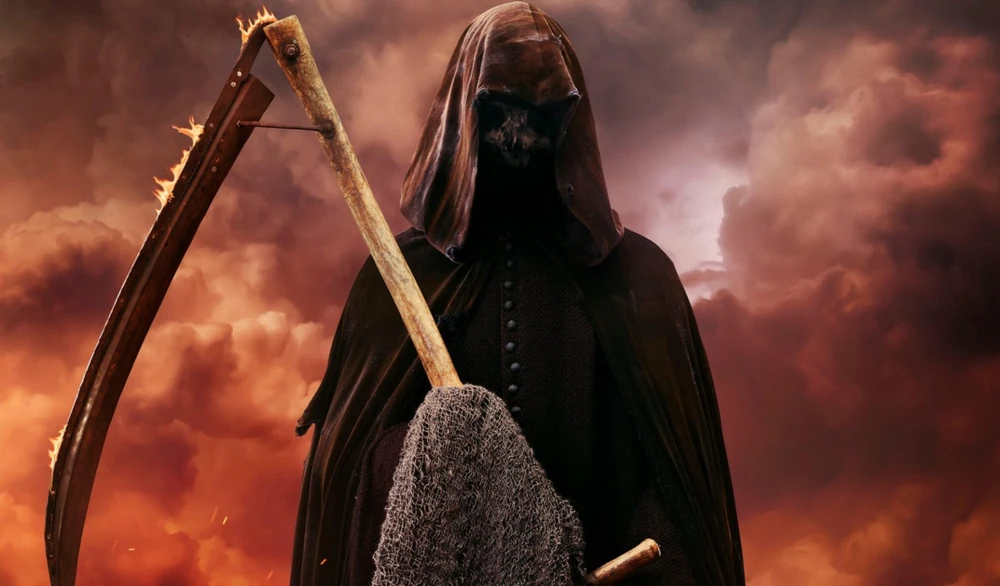Title: Good Omens
Authors: Terry Pratchett and Neil Gaiman
Rating: ⭐⭐⭐⭐
You are not reading a review of Good Omens – it is a literary analysis. I shall assume you have read Good Omens. If you have not, please do so before you read further. It’s a short, easy-to-read book. More importantly, it is a good book (whoops, a spoiler!)
There are considerable spoilers here. Most are in the “Characters” and “Theme” sections. The “Plot, Pacing, and More” section should lack significant spoilers. Still, I take no responsibility for you reading the spoilers – I have warned you!
If you do not wish to read the book, you might watch season one of the Prime show. It is a very accurate adaptation of the book. There are some differences. I will cover some of them in the “Differences Between the Novel and the Series” section.
As literary studies go, this is short. I cannot cover every character, theme, or plot point. I will analyze what I consider the most compelling aspects of the book. If you wish to add to my analysis, leave a comment.
Without further ado, I will start my analysis of Good Omens!
Plot, Pacing, and More
Most of the book’s events occur on Armageddon Day. An eleven-year-old boy brings about the world’s end. It is a day predicted by one Agnes Nutter, allegedly the world’s only true prophet.
It is a day thousands of years in the making and opposed by almost nobody. The forces of heaven and hell certainly do not oppose it. A small part of the scant opposing forces is an angel and a demon best friend duo.
There might be a million Armageddon novels. However, I found this version refreshing, compelling, and rather amusing.
It reads more like a Pratchett novel than a Gaiman novel. Perhaps that is because Gaiman’s wittiness blends well with Pratchett’s style of humor. Or, perhaps, as I am more of an experienced Pratchett reader than a Gaiman reader, I noticed more of the Pratchett style.
It bears much of the humor typical of a Pratchett novel. Gaiman’s whimsical wit is abundant. The atmospheric and eerie writing style of Gaiman blends in so well with the weird and compelling writing style of Pratchett.
The plot gets going rather fast, with relatively little setup time. Good Omens thrusts us into Armageddon early on. Many events occur, especially since most of the book happens in one day, with a significant amount in the latter half.
The novel is fun – sometimes a little too fun. Important, compelling scenes sometimes cut away to arguably unnecessary or ill-placed scenes. That creates several pacing issues. However, this is nothing serious, and they do not significantly impact the flow of the novel.
For instance, it spends time on hilarious moments that seem out of place. Most of the moments with the Four Horsemen are examples of such scenes. Some such scenes are rather humorous. However, they seem unnecessary. Some seem somewhat drawn out.
Multiple factors swiftly converge towards the rushed end. You expect more than what happens – and then it ends almost abruptly. Despite this, the ending is compelling. It makes sense and is consistent with the book’s themes. However, it is hard to deny that it is a little rushed. It is hard to deny that elements of the ending do not seem necessary.
The nuclear and ecological Armageddon is predictable. That makes sense, given its 1990 publication date. All the same, the ending is predictable. I saw much of it coming from several miles away. Perhaps the way the world is ending is not surprising. The world is ending. Why not use this as an excuse for commentary about pollution and nuclear technology? Never mind whether these are credible concerns. The authors think they are. Although, their points are a little ham-fisted.
However, none of these issues prevented me from enjoying the book. Despite its pacing and other issues, the plot is brilliant, entertaining and tackles some compelling themes.
Characters (Spoilers)
The main characters are Aziraphale, Crowley, Anathema Device, Newton Pulsifier, Shadwell, Madame Tracy, Adam, and Adam’s friends, The Them. The Them dominate the story, have some of the most impact on the story, and are central to the novel’s themes.
I rather liked Aziraphale and Crowley. The latter might be a demon. However, he doesn’t show much commitment to the demonic routine. He loves Earth enough to be a sympathetic character. Crowley has spent considerable time here. He loves watering plants and driving his Bentley. He enjoys listening to the Velvet Underground and everything.
Aziraphale might be an angel. However, he is not enough of a boring choir-going Gods-boy to be uninteresting. He runs a second-hand bookshop. And loves restaurants. And he is very fond of the Sound of Music movie. He and Crowley have a powerful attachment to the material world and its pleasures. He opposes his angelic instincts and upbringing.
Their friendship is captivating, especially so because of its forbidden nature. Yes, they are on opposing sides. So what? Why should that stop a great friendship? They will not let a small thing like Armageddon stop their friendship!
Why would an angel and a demon cooperate? They both love this world. Both are unusual. Both are more evil or good than they are supposed to be. They are both more morally ambiguous than they are supposed to be. Neither Aziraphale nor Crowley care for the war between their respective sides. They want to enjoy their time on Earth and their time together. There are many reasons for them to work together, and I loved everything that brought them together.
Adam is the Antichrist. He is an eleven-year-old boy. Adam wants to have fun with his friends. He loves riding his bike and playing with his friends, The Them. Adam and The Them love debating mysterious nonsense such as UFOs, Atlantis, and Tibetan Monks who allegedly dig through the Earth.
He is a typical eleven-year-old boy. Granted, very few eleven-year-old boys have inherited the powers of Satan. No other young boy has the power to bring about Armageddon. No, in that he is unique. And he is the sort of little twerp you cannot help but find adorable. So are his friends, The Them.
The Them is the name for Adam and his gang of friends: Brian, Wensleydale, Pepper, and later in the novel, his pet dog, known as Dog. The human members of The Them might seem like minor characters. However, they are not. As we shall see, they are crucial.
Dog was delightfully cute. He helps show how human Adam is. He was unaware of what it was. But it showed that despite being the Antichrist, that deep down, Adam is an average human boy. And not evil incarnate.
He is the Hellhound sent to aid Adam in bringing about Armageddon. Unfortunately, although Adam desires a dog, he wants one of those hopelessly cute, tiny dogs with one ear that flops down. Unfortunately, it is in the hound’s nature to take the form his creator wishes. And so, he becomes the pet Adam wants him to be. By the end, nothing hellish remains in him.
Making the human members of The Them generic and non-distinct would have been easy. However, each member of The Them has a sufficiently compelling, distinct personality to make them somewhat interesting. However, I found Pepper and Wensleydale the most interesting. Brian seemed to contribute the least.
The character of Anathema Device is crucial to the plot themes of the novel. However, I did not find her overly interesting. Perhaps it was her rabid and unreasonable belief in the prophecy of Agnes Nutter. The prophecy the book made abundantly clear was not as reliable as she believed. That made her seem less reasonable and sympathetic than she otherwise might have. Or, perhaps, she was not a very interesting character.
I had similar issues with Newton Pulsifer. I enjoyed the gimmick of his curse of almost instantly firing electronics upon touching them. They did not explain this. But perhaps it is not important. It proves to be a plot device later on. However, I am not sure it is a necessary plot device.
His primary purpose in the novel seemed to be to counter Agne’s unreasonable faith in the prophecies of Agnes Nutter. That is a valid contribution. His contribution near the end seems unnecessary. That’s why I call it a gimmick.
Gaiman and Pratchett might have cut Newton from the novel. Crowley might have played the role of prophecy skeptic. He held the book for some time. However, that could have slowed the plot. Perhaps it was best Newton played that role.
My issues with Newton and Agnes do not much detract from my enjoyment of their scenes. Their scenes, though not always as tightly written, were still entertaining.
Madame Tracy is a clairvoyant who appears later in the novel. Tracy exists to play host to Aziraphale after he accidentally disincorporates himself. And to help make a point about human kindness regarding Shadwell. Otherwise, her role is not very significant.
She is not a standout character. I have no problem with this. Her character is not well-developed. However, that is not an issue. The story does not require it.
Shadwell is a more well-developed character than Madame Tracy. Shadwell plays a relatively minor role in the novel other than to disincorporate Aziraphale. Although he gets more development than Madame Tracy, it is not by a great deal. I found him more interesting than her. Although, like Newton, the novel might work without him. He serves to motivate Newton in his actions.
Perhaps they could have combined Newton and Shadwell into one character. That would have denied Madame Tracy a love interest and her happy ending. Was it strictly necessary? I suspect it might not have been.
Perhaps I am over-analyzing. Perhaps Newton and Shadwell should be distinct characters. It is not as though I disliked them. I am just unsure if they were both necessary.
Let’s not forget the Four Horsemen of the Apocalypse. They get a fair amount of coverage in this book. More than I think is justified. Fans of the Prime series may know that their presence there has decreased significantly.
That’s the optimal approach. The book gave too much attention to the Horsemen. Their scenes were entertaining. However, they did not significantly contribute to the plot, and their scenes were sometimes distracting. These scenes hinder the flow of the novel.
There are many other characters. Regrettably, I cannot cover them because of time constraints.
Let me add one more thing: Gaiman likely enjoyed creating these characters. The book has many quirky characters here. Even those that do not seem strictly necessary are at least interesting. Pratchett is surely also to thank for that.
Themes (Spoilers)
Before I begin this section, I will remind the reader of the purpose of this review. Consider the theme of good vs evil and how the novel suggests everyone is morally gray. However, I do not believe everyone is morally gray.
My disagreement does not alter the book’s position. If we are to judge the book qua art, we should judge how well the book presents the position. Not whether we agree with that position – that is a separate issue.
I will mention if I take issue with other themes in this book. However, I shall not go into detail. This review will judge this book as an art form, not a philosophical treatise.
The book’s opening makes one of the central themes obvious: the hypocrisy of organized religion. God gives people free will. However, he expects them to trust him for no reason. God expects them to have faith in him.
Adam and Eve did not possess the knowledge of good and evil. When they sought it, God punished them by banishing them from paradise. How was he to know that was wrong? They were supposed to take it on faith and not exercise the full extent of their free will. Why give man free will if he wished to keep them ignorant and subservient to their faith? Truly ineffable.
The novel examines the themes of good and evil. Aziraphale and Crowley are on opposing sides of the divine war between Heaven and Hell. But neither are perfectly good or evil. The novel argues that everyone – mortal and divine – is sometimes good and bad. Nobody is purely good or evil – there is always some moral ambiguity or shade of gray.
Many are morally ambiguous because they lack the conviction to take a clear moral stance. However, not everyone is morally gray. Many take a clear stance, for good or evil. The novel expresses this well. That counts more than anything.
The theme explores the difficulty of judging someone’s character based on appearance alone. The armies of darkness made the Antichrist into the form of an eleven-year-old child. Who could have known just by looking? Nobody. Not right until the day of Armageddon.
Despite the intentions of the armies of darkness, the Antichrist grows up as an average rural English boy. Once he realizes his world-ending powers, he gives them up so that he and his friends can lead a happy life. That shows that not even the Antichrist must be evil. Even the Antichrist can choose between good and evil.
Another theme is that of friendship. Aziraphale and Crowley have been friends for 6,000 years. They do not let the fact that they are on opposite sides of the eternal war between Heaven and Hell impede a wonderful friendship! Isn’t that touching?
Their friendship helps illustrate a theme I mentioned earlier – that nobody is fully good or evil. Neither Aziraphale nor Crowley are truly good or evil. And that makes their friendship work! Crowley quips that his angelic friend is “just enough of a bastard to be worth liking.”
Their friendship would not work were Aziraphale purely good or Crowley pure evil. That is why their friendship works. It is also one of the many ways Pratchett and Gaiman deftly integrate the novel’s several themes.
Adam and his friends have a tight-knit friendship in The Them. Adam is ready to destroy the world. Only his strong bond with his friends helps him rein in his powers and realize that he is terrifying his friends and not acting in their interest. That brings him down from the edge of Armageddon.
Friendship helped save the day. It helped convince Adam not to end the world. It allowed Aziraphale and Crowley to help work together. You might think it sounds cheesy, but it is not. Friendship is important. It can bring out the best in us.
Another theme is that of free will versus destiny. Anathema Device makes much of the claim that the prophecies of Agnes Nutter are accurate. However, is this the case? Her ancestors have spent three hundred years analyzing her prophecies, and almost none seem to make sense – except in retrospect.
Nutter’s writings make no sense. It is almost impossible to match them to anything in advance. However, it is possible to match them to events after they happen and then assume that is what Nutter predicted. That is not a prediction; that is a post-diction.
It is easy to take seemingly random nonsense and make it seem to predict something that happened in the past. That is how Nostradamus appears to make predictions. That is how Nutter’s ancestors make it appear as though her prophecies are accurate.
It is easy to believe in prophecies if you take vague nonsense and only identify what that nonsense means after the events happen. It is easy to pretend that the nonsense was a prediction. The nonsense could have meant nothing or nearly anything.
Are destiny and free will two sides of a coin? Good Omens argues that. Aziraphale and Crowley both believe that they are likely powerless to prevent Armageddon. Aziraphale believes it is part of God’s ineffable plan, and Crowley believes Satan wants the end to come. Still, they try to stop it.
Why should they attempt to stop Armageddon? It would seem that God and Satan both wish for Armageddon. They both desire the last war to decide whether the universe shall be good or evil.
Crowley argues an angel should stop the triumph of evil. And is it not Crowley’s duty to stop the victory of good? Therefore, is it not perhaps part of the larger plan for them to prevent Armageddon? How are they to know? It is all very ineffable, as Aziraphale likes to say.
Near the end, Adam refuses to mobilize the Four Horsemen. Death claims Armageddon is “Written,” but Adam counters that what is “Written” can be crossed out and rewritten. Writing does not invalidate free will.
Aziraphale and Crowley maintain that an Ineffable Plan is inherently elusive and adaptable. Destiny is not something set in stone – it is whatever people make of it. Free will is what ultimately matters. Destiny said Adam was supposed to end the world. Yet, he chose not to.
Good Omens posits that one thing that defines humanity – as opposed to demon and angel kind – is their immense capacity for cruelty, kindness, and creativity.
The demons gave Crowley credit for the Spanish Inquisition. However, that was a product of creative human cruelty. Something Crowley believes is beyond the unimaginative cruelty of demons. Only a human could conceive of that kind of innovative cruelty. Crowley believes humans are capable of cruelty beyond the imagination of demons.
However, Madame Tracy always makes Sunday lunch for neighbor Shadwell, even though he is a disagreeable and ungrateful grump. Good Omens argues for the better side of humanity where kindness and benevolence shine through. She seeks companionship with him even though he might, superficially at least, appear to be an unlikeable man.
Anathema Device attempts to prevent Armageddon for allegedly altruistic reasons. Some might see this as proof of the goodness of humanity. I do not consider altruism to be rational or noble. However, that is moot. There is nothing altruistic about saving the world. If you save the world, is it not in your self-interest?
However, the best example of this theme is Adam, the Antichrist. He has an enormous capacity for evil. However, he rejects it and rejects the innate evil within him. He elects to live as an innocent child – free of the evil of the Antichrist. If he can reject evil, then so can anyone. Whatever evil is within us is a choice.
The book presents the idea that good and evil exist within us all, but this is false as they are choices that we make. Some of us choose both.
Differences Between the Novel and the Series
There is a mini-series adaptation of the novel. Series one of the Good Omens Prime Video series is very faithful to the book. However, as you should expect, differences exist.
Aziraphale and Crowley are much more prominent in the Prime Video show. They are the main characters in the book. Long sections of the book go by where they do not appear, unlike the Prime Video show.
Gabriel and other characters from Heaven and Hell – such as Beelzebub – barely appear. They appear rarely in the book but have plenty of screen time in the show.
The Four Horsemen receive significantly less screen time in the mini-series. That is an appreciable change that helps give the Prime Video show better pacing.
Viewers of the Prime series will remember a bit at the end involving a trick involving the forces of Heaven and Hell. Unfortunately, that is not in the book. The book ends almost immediately after the aversion of Armageddon – unlike the Prime show.
Conclusion
Good Omens is a fun and quirky story about friendship and free will. It has a lot to say about many things, but it is, above all, a fun story. If you enjoy the quirkiness of Neil Gaiman’s characters and his worlds, you will love this book. Whether you enjoy Pratchett and Gaiman or want a humorous take on friendship, free will versus destiny, or other compelling themes, this book is for you.
It’s a funny tale of two friends saving the world from Armageddon. That is all right – that is as good a reason to love Good Omens as any other. There is much more to Good Omens than that – but take away what you will.
It is not my place to tell you what you should value. I like what it says about free will and prophecy. It is instructive to apply this to religion. Here, you can choose from a variety of riches. Take your pick.
Hopefully, we can all agree that it is well-written, intelligent, fun, and packed with quirkiness. Pratchett and Gaiman set out to do so – and they succeeded. Congratulations to them both!





